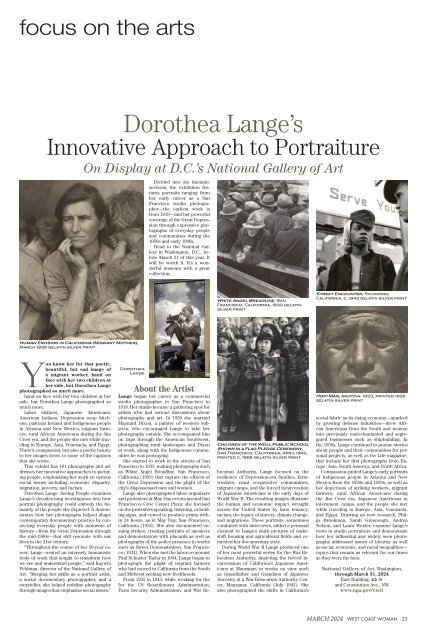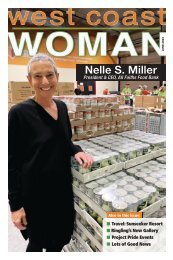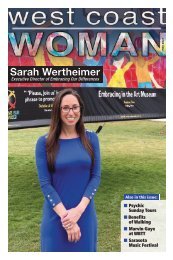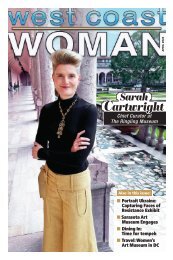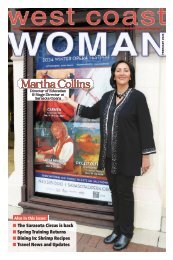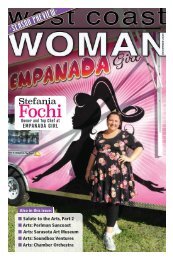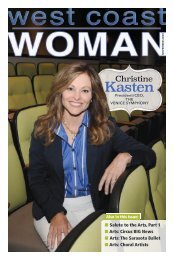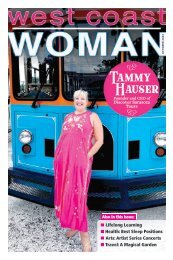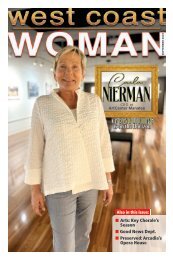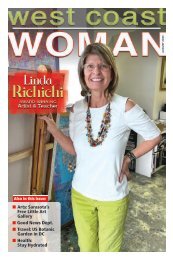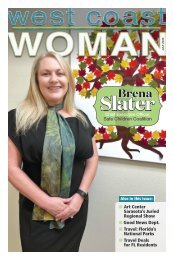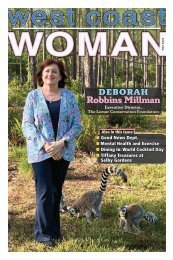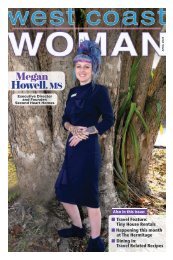wcw3-24
This month's WCW has an interview with Dr. Fiona Crawford at the Roskamp Institute. Other features: Embracing Our Differences, Chorals Artists, The Ringling's latest exhibit, quinoa recipes, Good News, an exhibit in Washington, DC on Dorothea Lange, You're News, a feature of safe swimming, news about the Set The Bar event and another feature on investing for women.
This month's WCW has an interview with Dr. Fiona Crawford at the Roskamp Institute. Other features: Embracing Our Differences, Chorals Artists, The Ringling's latest exhibit, quinoa recipes, Good News, an exhibit in Washington, DC on Dorothea Lange, You're News, a feature of safe swimming, news about the Set The Bar event and another feature on investing for women.
- TAGS
- barancik
- safe children coalition
- neal communities
- caldwell trust company
- lakewood ranch women’s club
- bradenton
- sarasota
- sunshine from darkness
- your news
- the highway men
- artist series concerts
- miracle swimming
- good news
- embracing our diffrences
- national gallery of art
- recipes
- access advisors
- craniosacral therapy
- choral artists
- the ringling
Create successful ePaper yourself
Turn your PDF publications into a flip-book with our unique Google optimized e-Paper software.
focus on the arts<br />
Dorothea Lange’s<br />
Innovative Approach to Portraiture<br />
On Display at D.C.’s National Gallery of Art<br />
Divided into six thematic<br />
sections, the exhibition features<br />
portraits ranging from<br />
her early career as a San<br />
Francisco studio photographer—the<br />
earliest work is<br />
from 1919—and her powerful<br />
coverage of the Great Depression<br />
through expressive photographs<br />
of everyday people<br />
and communities during the<br />
1950s and early 1960s.<br />
Head to the National Gallery<br />
in Washington, D.C., before<br />
March 31 of this year. It<br />
will be worth it. It’s a wonderful<br />
museum with a great<br />
collection.<br />
White Angel Breadline, San<br />
Francisco, California, 1933 gelatin<br />
silver print<br />
Street Encounter, Richmond,<br />
California, c. 1943 gelatin silver print<br />
Human Erosion in California (Migrant Mother),<br />
March 1936 gelatin silver print<br />
You know her for that poetic,<br />
beautiful, but sad image of<br />
a migrant worker, hand on<br />
face with her two children at<br />
her side, but Dorothea Lange<br />
photographed so much more.<br />
hand on face with her two children at her<br />
side, but Dorothea Lange photographed so<br />
much more.<br />
Labor strikers, Japanese Americans,<br />
American Indians, Depression soup kitchens,<br />
pastoral Ireland and Indigenous people<br />
in Arizona and New Mexico, migrant farmers,<br />
rural African Americans during the Jim<br />
Crow era, and the people she met while traveling<br />
in Europe, Asia, Venezuela, and Egypt.<br />
There’s compassion, but also a poetic beauty<br />
to her images down to some of the captions<br />
that she wrote.<br />
This exhibit has 101 photographs and addresses<br />
her innovative approaches to picturing<br />
people, emphasizing her work on various<br />
social issues including economic disparity,<br />
migration, poverty, and racism.<br />
Dorothea Lange: Seeing People examines<br />
Lange’s decades-long investigation into how<br />
portrait photography could embody the humanity<br />
of the people she depicted. It demonstrates<br />
how her photographs helped shape<br />
contemporary documentary practice by connecting<br />
everyday people with moments of<br />
history—from the Great Depression through<br />
the mid-1960s—that still resonate with our<br />
lives in the 21st century.<br />
“Throughout the course of her 50-year career,<br />
Lange created an intensely humanistic<br />
body of work that sought to transform how<br />
we see and understand people,” said Kaywin<br />
Feldman, director of the National Gallery of<br />
Art. “Merging her skills as a portrait artist,<br />
a social documentary photographer, and a<br />
storyteller, she helped redefine photography<br />
through images that emphasize social issues.”<br />
Dorothea<br />
Lange<br />
About the Artist<br />
Lange began her career as a commercial<br />
studio photographer in San Francisco in<br />
1918. Her studio became a gathering spot for<br />
artists who had serious discussions about<br />
photography and art. In 1920 she married<br />
Maynard Dixon, a painter of western subjects,<br />
who encouraged Lange to take her<br />
photography outside. She accompanied him<br />
on trips through the American Southwest,<br />
photographing rural landscapes and Dixon<br />
at work, along with the Indigenous communities<br />
he was portraying.<br />
She started to work in the streets of San<br />
Francisco in 1933, making photographs such<br />
as White Angel Breadline, San Francisco,<br />
California (1933) that capture the effects of<br />
the Great Depression and the plight of the<br />
city’s dispossessed men and women.<br />
Lange also photographed labor organizers<br />
and protesters at May Day events around San<br />
Francisco’s Civic Center Plaza: she focused<br />
on the protesters speaking, listening, or holding<br />
signs, and vowed to produce prints within<br />
<strong>24</strong> hours, as in May Day, San Francisco,<br />
California (1934). She also documented ensuing<br />
strikes, creating portraits of speakers<br />
and demonstrators with placards as well as<br />
photographs of the police presence in works<br />
such as Street Demonstration, San Francisco<br />
(1934). When she met the labor economist<br />
Paul Schuster Taylor in 1934, Lange began to<br />
photograph the plight of migrant farmers<br />
who had moved to California from the South<br />
and Midwest seeking new livelihoods.<br />
From 1935 to 1943, while working for the<br />
for the US Resettlement Administration,<br />
Farm Security Administration, and War Re-<br />
Children of the Weill Public School<br />
Shown in a Flag Pledge Ceremony,<br />
San Francisco, California, April 1942,<br />
printed c. 1965 gelatin silver print<br />
location Authority, Lange focused on the<br />
resilience of Depression-era families, farmworkers,<br />
rural cooperative communities,<br />
migrant camps, and the forced incarceration<br />
of Japanese Americans in the early days of<br />
World War II. The resulting images illustrate<br />
the human and economic impact wrought<br />
across the United States by farm tenancy,<br />
racism, the legacy of slavery, climate change,<br />
and migrations. These portraits, sometimes<br />
combined with interviews, added a personal<br />
element to Lange’s stark pictures of makeshift<br />
housing and agricultural fields and cemented<br />
her documentary style.<br />
During World War II Lange produced one<br />
of her most powerful series for the War Relocation<br />
Authority, depicting the forced incarceration<br />
of California’s Japanese Americans<br />
at Manzanar, in works on view such<br />
as Grandfather and Grandson of Japanese<br />
Ancestry at a War Relocation Authority Center,<br />
Manzanar, California (July 1942). She<br />
also photographed the shifts in California’s<br />
Hopi Man, Arizona, 1923, printed 1926<br />
gelatin silver print<br />
social fabric as its rising economy—sparked<br />
by growing defense industries—drew African<br />
Americans from the South and women<br />
into previously male-dominated and segregated<br />
businesses such as shipbuilding. In<br />
the 1950s, Lange continued to pursue stories<br />
about people and their communities for personal<br />
projects, as well as for Life magazine,<br />
that include her first photographs from Europe.<br />
Asia, South America, and North Africa.<br />
Compassion guided Lange’s early portraits<br />
of Indigenous people in Arizona and New<br />
Mexico from the 1920s and 1930s, as well as<br />
her depictions of striking workers, migrant<br />
farmers, rural African Americans during<br />
the Jim Crow era, Japanese Americans in<br />
internment camps, and the people she met<br />
while traveling in Europe, Asia, Venezuela,<br />
and Egypt. Drawing on new research, Philip<br />
Brookman, Sarah Greenough, Andrea<br />
Nelson, and Laura Wexler, examine Lange’s<br />
roots in studio portraiture and demonstrate<br />
how her influential and widely seen photographs<br />
addressed issues of identity as well<br />
as social, economic, and racial inequalities—<br />
topics that remain as relevant for our times<br />
as they were for hers.<br />
National Gallery of Art, Washington,<br />
through March 31, 20<strong>24</strong><br />
East Building, 4th St<br />
and Constitution Ave., NW<br />
www.nga.gov/visit<br />
MARCH 20<strong>24</strong> WEST COAST WOMAN 23


